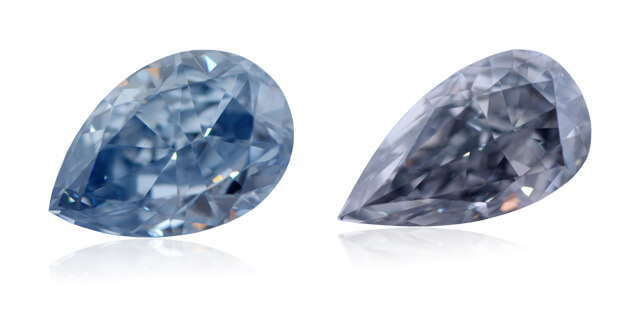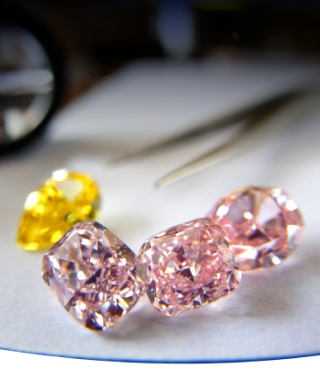In most cases, preference for a color’s undertone is a matter of personal taste. Notable preferences for certain undertones within each color category impact purchase figures, suggesting that most of us prefer certain undertones to others.
The relationship between preferred undertones to the high commercial premiums they receive may result from several factors. Early childhood associations with primary colors can leave a powerful impression and may help to explain the high demand for these stones. Unfortunately, a very small portion of fancy color diamonds are found in primary colors. This explanation will focus on this subcategory of exceptionally-colored gems.
YELLOW UNDERTONES
Large Yellow undertone variations appear from time to time. When they do, price fluctuations are noticeable, primarily in the “Vivid” category. Vivid Yellow diamonds with no green or brown undertone that exhibit a strikingly bright hue generate a substantial price premium. The difference in color between a ”primary color” yellow and a yellow with a brown or green undertone is considerable and should be noted.
BLUE UNDERTONES
Blue undertones are more diversified, and they obtain a premium when the hue is as close to a primary blue as possible with no traces of gray. The price discrepancy between a Fancy Blue free of any gray undertone and a Fancy Blue with noticeable traces of gray (but not enough to be classified as Fancy Grayish Blue) is very significant.
PINK UNDERTONES
Endless variations of undertones can be found in pink fancy color diamonds. Each geographical source of pinks (commonly Australia or Russia) is usually characterized by a specific undertone. Often, the preconceived notion of “pink” as we imagine it does not live up to the gemological definition on the report. We have learned that the most desired pink undertone has a soft presence of purple, which sweetens the color but does not correspond to any precise scientific definition of a straight pink used by gemological laboratories. It has been argued that this preference is due to basic associations that make terms like “baby pink” or “bubble gum pink” so common in the trade. Alternatively, a pink with a touch of orange, termed “antique pinkת” is found at the lower end of the pink value scale. Pink is not a pure color as most of us imagine it, and is composed of blue and red.
THE VALUE OF MODIFIED COLOR DIAMONDS
Many fancy color diamonds are graded on the report as composed of more than one color. These stones have a main body color plus one or two color modifiers. Some color combinations can also have an undertone that is not stated on the report, and can impact the diamond’s appearance and value.
A yellowish green diamond is a good example of color undertone significantly impacting a stone’s price. These undertones create a phosphorescent appearance known as “apple green” or “radioactive green”. This unique color sensation will yield a significantly higher price than a color combination with a smoky green appearance or an “olivey” color sensation (with a gray undertone), even though their gemological definition may be the same.
It is therefore clear that a color’s undertone, which can only be determined when the diamond is viewed physically, greatly impacts a diamond’s commercial value, regardless of the color classification the stone received at a diamond laboratory. This further reinforces the notion that a diamond’s grading report is not the sole factor to consider when evaluating its worth. The challenges of understanding, appreciating, and valuing fancy color diamonds is one of the driving forces behind the creation of the Fancy Color Research Foundation.


